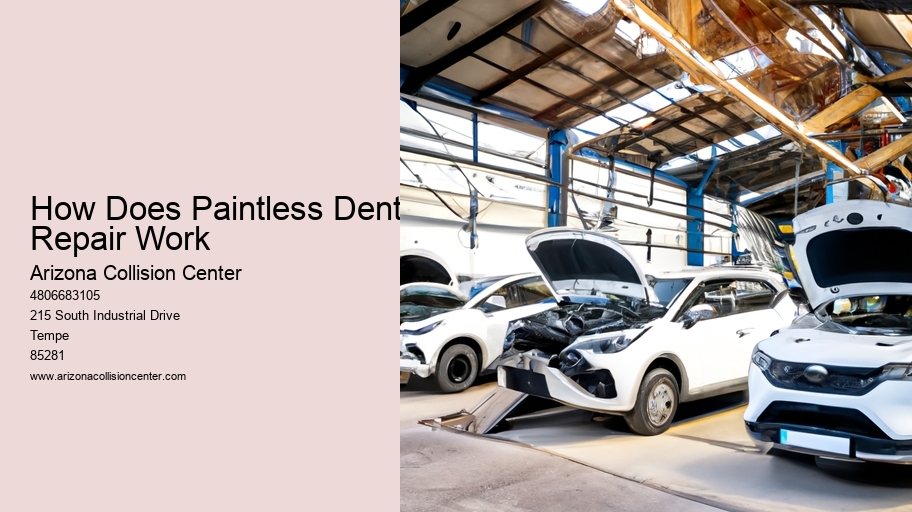In the realm of automotive aesthetics, there exists a revolutionary technique known as Paintless Dent Repair (PDR). This method, akin to a masterful symphony, orchestrates the art of removing dents without the tedious and expensive process of repainting.
By employing specialized tools and an intricate step-by-step process, PDR craftsmen can resurrect the sleek contours of a vehicle, erasing the evidence of unfortunate encounters.
Join us on a journey to unravel the secrets behind this transformative method and uncover the myriad benefits it bestows upon discerning car owners.
Tools Used in PDR
- Paintless dent repair (PDR) requires a specific set of tools to effectively remove dents without the need for repainting. These tools are designed to manipulate the metal surface back to its original shape, restoring the vehicle's appearance.
Common tools used in PDR include a variety of specialized rods, hooks, and picks. These tools are made of durable materials such as stainless steel and are designed to reach behind the dent and apply controlled pressure to reshape the metal. The technician carefully selects the appropriate tool based on the size, location, and depth of the dent.
In addition to these common tools, PDR technicians also utilize alternative methods such as glue pulling. This technique involves applying a special glue to a plastic tab, which is then attached to the dent. Pulling on the tab with a specialized tool allows the technician to gradually lift the dent back into place.
Ultimately, these tools and techniques enable PDR technicians to restore the vehicle's original appearance without the need for costly and time-consuming repainting.
Step-by-Step Process of PDR
The step-by-step process of Paintless Dent Repair (PDR) begins with the selection of the appropriate tools and techniques discussed in the previous subtopic. Once the tools are ready, the technician assesses the damage by inspecting the dent's size, depth, and location. This evaluation is crucial in determining whether PDR is suitable for the specific dent.
If PDR is deemed appropriate, the technician uses specialized tools to gently massage the dent from the underside, gradually restoring the panel's original shape without the need for paint or fillers. The process requires skill and precision, as the technician must carefully manipulate the metal until the dent is completely removed.
The cost of PDR varies depending on the size and severity of the dent, while the time required for PDR is typically shorter compared to traditional dent repair methods.
Benefits of Paintless Dent Repair
One advantage of Paintless Dent Repair (PDR) is the ability to restore a vehicle's appearance without the need for traditional repair methods. PDR is a cost-effective solution that eliminates the need for extensive bodywork, repainting, and replacement parts.
By using specialized tools and techniques, skilled technicians can gently massage the dent from the inside out, preserving the original paint and finish of the vehicle. This not only saves time but also reduces the overall cost of repair, making PDR an attractive option for those who want to restore their vehicle's appearance without breaking the bank.
Additionally, PDR is a non-invasive process that does not involve sanding, filling, or painting, resulting in a faster turnaround time and allowing the owner to retain the freedom of their vehicle without lengthy repair periods.
Types of Dents That Can Be Repaired With PDR
Various types of dents can be effectively repaired using Paintless Dent Repair (PDR) techniques. PDR is a versatile method that can address a wide range of dent sizes and shapes. Here are some common types of dents that can be repaired using PDR:
Small dents: PDR is especially effective in fixing small dents, such as those caused by hailstones or minor collisions. The flexible nature of PDR tools allows technicians to access and manipulate these dents easily.
Creases: PDR can also tackle creases, which are longer and more defined dents. Skilled technicians can work from behind the panel to gradually massage out the crease, restoring the smooth surface.
Large dents: While PDR is primarily used for smaller dents, it can still be employed for larger dents with certain limitations. The size and accessibility of the dent may determine the feasibility of using PDR.
Aluminum panels: PDR techniques can be used on various materials, including aluminum, which is commonly used in modern vehicles. Specialized tools and techniques are employed to safely and effectively repair dents on aluminum panels.
Common Myths About Paintless Dent Repair
There are several misconceptions surrounding Paintless Dent Repair (PDR) that are important to address.
One common myth is that PDR techniques are only suitable for small dents. However, PDR can effectively repair dents of various sizes, including larger ones, as long as the paint has not been damaged.
Another myth is that PDR is an expensive repair option. On the contrary, PDR is often more cost-effective compared to traditional dent repair methods. The cost of paintless dent repair depends on factors such as the severity and location of the dent, but it is generally more affordable than conventional repairs that require painting and sanding.
Understanding the Different Types of Automobile Warranty Coverage Plans Available
